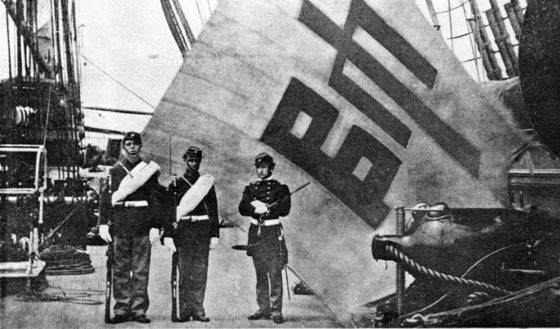
“During the first half of the 19th century, waves of newcomers from Europe streamed into America, all in search of land, opportunity and a life free from strife and persecution. Sadly, the peace they dreamed of would be interrupted.”
THERE WERE AN ESTIMATED 31 million people living in the United States on the eve of the Civil War. Sixty years early the population was just approaching 5 million. It was a remarkable demographic explosion and one made possible only because of immigration.
During the first half of the 19th century, waves of newcomers from Europe streamed into America, all in search of land, opportunity and a life free from strife and persecution. Among their ranks were Scots, Germans, Ukrainians, Irish, Italians, and others.
Sadly, the peace and prosperity they dreamed of would be interrupted by one of the most destructive conflicts of the era — the American Civil War. And hundreds of thousands of these immigrant Americans would be swept up into the struggle.
While the Confederate States were decidedly less culturally diverse than the north (only 9 percent of southerners were immigrants) the majority of those living above of the Mason Dixon Line (55 percent) were foreign born. Many of these new Americans volunteered to fight for their adopted country; others were conscripted. Some formed regiments comprised almost entirely of immigrants from their old countries. Let’s take a look at some of these units.

Germans in Blue and Grey
Of the 2.2 million men who served in the Union Army during the Civil War, more than 200,000 were German. Not surprisingly, a significant number of all-German regiments were raised to fight in the Union Army.
The 8th New York Volunteer Infantry Regiment was just one of these outfits. Commanded by a 49-year old Bavarian immigrant with a long military career in Europe by the name of Louis Blenker, the 8th, also known as the First German Rifles, was celebrated for covering the Yankee retreat from the First Battle of Bull Run in July of 1861. The outfit was disbanded in 1863 amid charges of corruption against Blenker and after the regiment stood accused of plundering civilian settlements.
Other German units included the 68th New York Volunteer Infantry Regiment, the 52nd New York German Rangers, the 9th Ohio, 74th Pennsylvania and the 32nd Regiment Indiana Infantry. Many of these units were noted for their harsh Prussian-style discipline and tight esprit de corps. Southern propagandists likened the German Union regiments to the much hated Hessian “mercenaries” of the American War of Independence.
The Confederate army had fewer immigrants in general than the Union and only about 5,000 Germans in its ranks. Despite this, there was the German Fusiliers of Charleston, South Carolina that fought for the rebellion. Founded in 1775 by patriot colonists of Teutonic descent, the unit remained as an ethnic militia unit right up into the Civil War.

Irish and Scots
More 150,000 troops in the Union Army hailed from Ireland. Many of these soldiers arrived in the States following the Potato Famine of the 1840s. Units such as the 37th New York Volunteer Infantry Regiment and the 90th Illinois Volunteers were comprised of new arrivals from the Emerald Isle, as were the troops and officers of the “Fighting 69th” Infantry Regiment of New York, also known as the Irish Brigade. Interestingly enough, this unit was almost entirely wiped out at the Battle of Fredericksburg in December of 1962 when it went up against a Confederate unit made up largely of Irish-born troops that had settled in the south. The brigade went into battle in December of 1862 with 1,600 men and came out with fewer than 300.
The 69th continued to serve throughout the Civil War and would fight again in the Argonne Forrest in France during the First World War as well as the Pacific in World War Two. In 2003, the 69th Infantry Regiment, now a New York State National Guard outfit, fought in Iraq where it secured the vital Baghdad Airport Road, which was designated the Route Irish in the unit’s honour. Immediately after the Civil War, Irish units from both the Union and the Confederacy would join forces to invade Canada as part of a movement to topple the British Empire.
It wasn’t Irish that made up the New York 79th Regiment, but Scottish Americans. Formed in the late 1850s by new arrivals from Scotland, the regiment adopted its own variation of the uniform of a British highland regiment, right down to their tartan kilts. Even the unofficial name for the unit, the Cameron Highlanders, was a crib of the British Army’s Queen’s Own 79th Regiment of Foot.

Other Immigrant Regiments
- New York’s 39th Volunteer Infantry Regiment was made up entirely of ethnic companies from various backgrounds. Three German platoons, three Hungarian, one Swiss, one Italian, one Spanish and one French platoon made up the 39th.
- A small number of Hispanic regiments served the Rebel cause. These included: the 5th Regiment of Louisiana – the so-called European Brigade; the Spanish Guard of Mobile, Alabama; and the Benavides Regiment of Texas. This largely Mexican outfit fought at 2nd Manassas, Antietam, Gettysburg and were with General Lee at Appomattox Courthouse.
- Up to 5,000 Polish immigrants took up arms for the Union. In fact one unit, the 58th New York Regiment, known as the Polish Legion, was even commanded by a native of the old country: Brigadier General Wlodzimierz Krzyzanowski.










Wisconsin had at least two regiments made up of Germans as well as many company sized units within other regiments. Great post.
Who wrote this so I can reference it in an essay?
NH Mallett